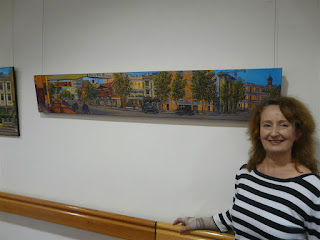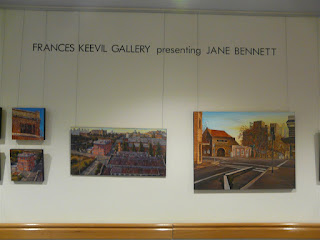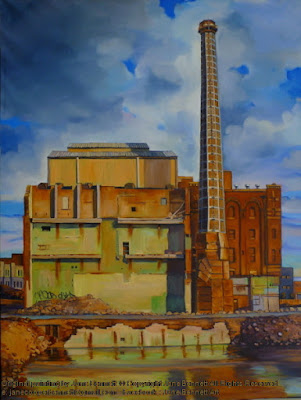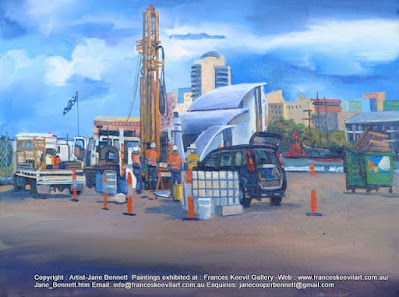 |
| Hanging my exhibition St Vincent's -In the Art of Darlinghurst Enquiries about these paintings: janecooperbennett@gmail.com |
 |
| Hanging my exhibition St Vincent's -In the Art of Darlinghurst Enquiries about these paintings: janecooperbennett@gmail.com |
 |
| Hanging my exhibition St Vincent's -In the Art of Darlinghurst Enquiries about these paintings: janecooperbennett@gmail.com |
 |
| Hanging my exhibition St Vincent's -In the Art of Darlinghurst Enquiries about these paintings: janecooperbennett@gmail.com |
 |
| Hanging my exhibition St Vincent's -In the Art of Darlinghurst Enquiries about these paintings: janecooperbennett@gmail.com |
 |
| Hanging my exhibition St Vincent's -In the Art of Darlinghurst Enquiries about these paintings: janecooperbennett@gmail.com |
 |
| Hanging my exhibition St Vincent's -In the Art of Darlinghurst Enquiries about these paintings: janecooperbennett@gmail.com |
As the Xavier Art Space is a long corridor, I decided to add another 16 or so paintings of other inner city streetscapes.
Most of these other paintings whether of Pyrmont, White Bay, Surry Hills, Darlinghurst or Waterloo seem to be of pubs or former pubs. Derelict pubs like the Terminus, recently closed pubs like the Hopetoun, pubs that were burnt down in the dead of night under mysterious circumstances like the White Bay Hotel, or pubs that had a narrow escape from these fates and are enjoying a precarious Renaissance like the Iron Duke. There are also 2 paintings of the half-demolished Carleton United Brewery.
A minor irony was that Dr Robert Graham, who had kindly agreed to open my exhibition, was the head of Drug and Alcohol Treatment. Another minor irony is that I am (and have always been) a teetotaller.
 |
| Hanging my exhibition St Vincent's -In the Art of Darlinghurst Enquiries about these paintings: janecooperbennett@gmail.com |
 | ||
| Hanging my exhibition St Vincent's -In the Art of Darlinghurst Enquiries about these paintings: janecooperbennett@gmail.com |
 |
| Hanging my exhibition St Vincent's -In the Art of Darlinghurst Enquiries about these paintings: janecooperbennett@gmail.com |
 |
| Hanging my exhibition St Vincent's -In the Art of Darlinghurst Enquiries about these paintings: janecooperbennett@gmail.com |
"By the side of the road " is the common idiom, however this road was actually a street. "On the road" sounds almost romantic, evoking the ghost of Jack Keroac, whereas "on the street" has an air of desperation. I am often "on the road" when I paint - my car is a mobile studio with a fold-up table and chair and a French box easel in the boot at all times. I am not a "street" artist in the sense of a graffiti artist such as "Banksy", as I take my paintings home when I have finished painting them, although I bet that I spend a lot more time actually painting in the street. According to one definition Street Art is traditionally unsanctioned as opposed to a government funded initiatives . The artist attempts to have their work communicate with everyday people about socially relevant themes by placing their work in non-art contexts. In that sense, my art is definitely "street".
Many years ago a witless journalist stunned me into silence during a radio interview. After hearing a description of how I explored Sydney's urban landscapes outdoors instead of painting in my studio from photos, he turned the interview into farce by describing my art as "streetwalking".
English can be a dangerous language full of traps for the unwary.
The word "street" I discovered has some odd quirks of meaning aside from its obvious use as a word for a paved thouroughfare. Some of these carry a lot of pejorative nuances.
Definitions of "Street"
- a situation offering opportunities ("He worked both sides of the street")
- as a depressed environment in which there is poverty and crime and prostitution and dereliction ("She tried to keep her children off the street")
- The people who spend a great deal of time on the street in urban areas, especially the young, the poor, the unemployed, and those engaged in illegal activities.
- (slang) Street talk or slang.
- (figuratively) a large amount ("He's streets ahead of his sister in all the subjects in school.")
- (poker slang) Each of the 3 opportunities that players have to bet, after the flop, turn and river.
- Illicit, contraband, especially of a drug:e.g. "street drugs".
- not in prison, or released from prison. ("He's on the street again after leaving Long Bay jail")
- Without a home; without the means to afford good shelter.
- without a job or occupation; idle.
The term "street" is used with the preposition "in". Something is "in" the street, but "in" or "on" the road. To be "on the street" means to be living an insecure life, often one associated with homelessness or crime. To "hear something on the street" means to learn about something through rumor.
In the Middle Ages, a road or way was merely a direction in which people rode or went, the name street was always reserved for the built road.
The "Man in the street" meaning the ordinary non-expert person, is first recorded in 1831. Street-car is first recorded 1862. Street-walker "common prostitute" first recorded 1590s. Street people is first recorded 1967; street smarts is from 1972; and street-credibility is from 1979.
The good and bad points of the urban environment are captured by the many meanings of the term "street" . It carries a feeling of fast-paced opportunity, reality and authenticity - but also uncertainty, edginess, decay and even a whiff of danger.
All the photos in this post were kindly taken by Frances Keevil, Director of the Frances Keevil Gallery, who also did most of the work hanging my show
Update
The redoubtable flaneur and photographer Julie of "Sydney Eye" took some great photos at the opening of my exhibition which can be seen at "The poof factor"






